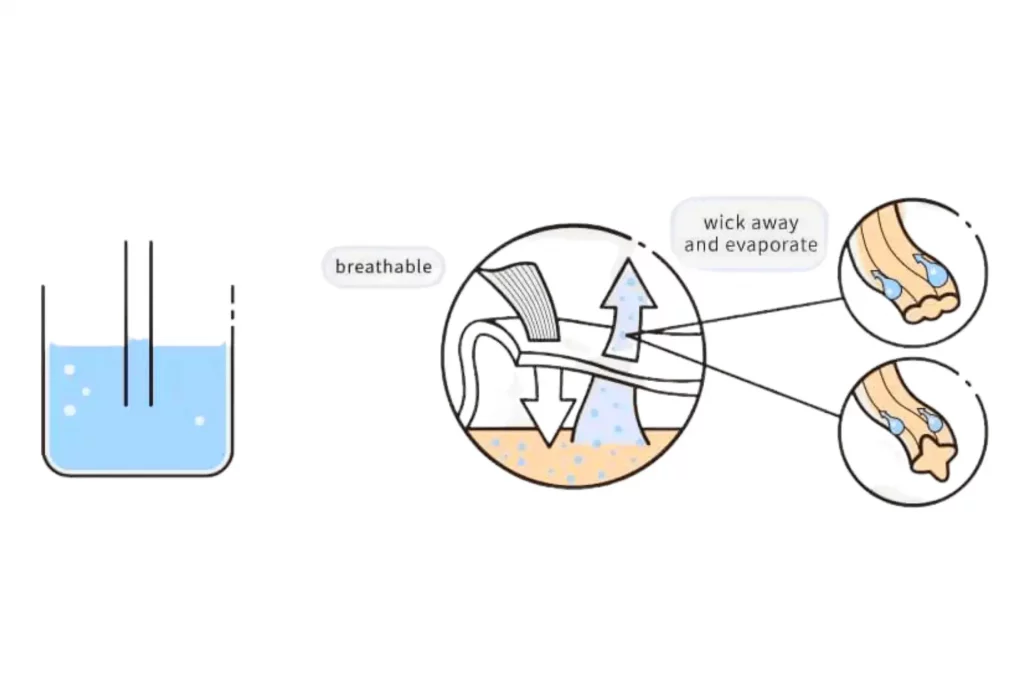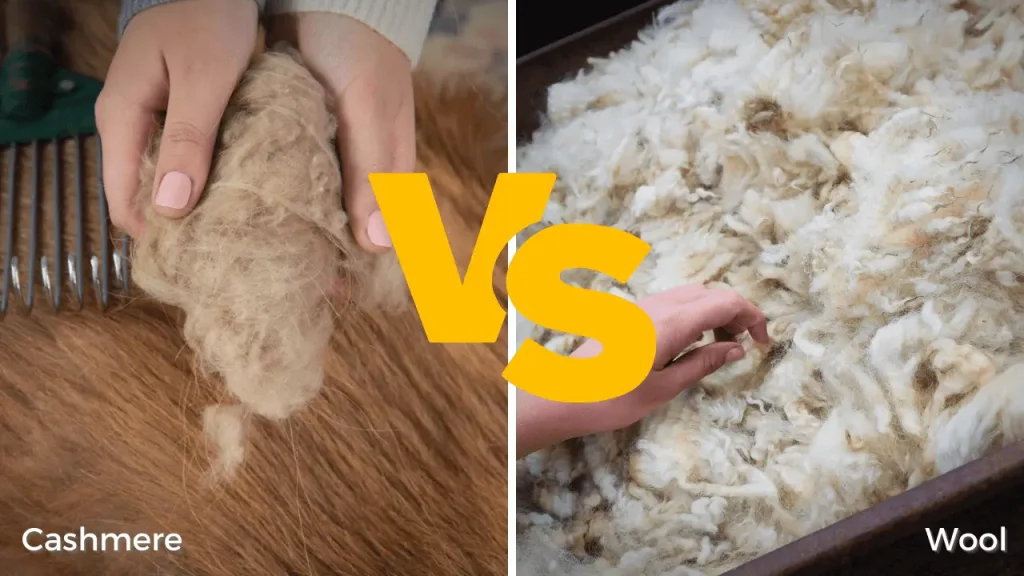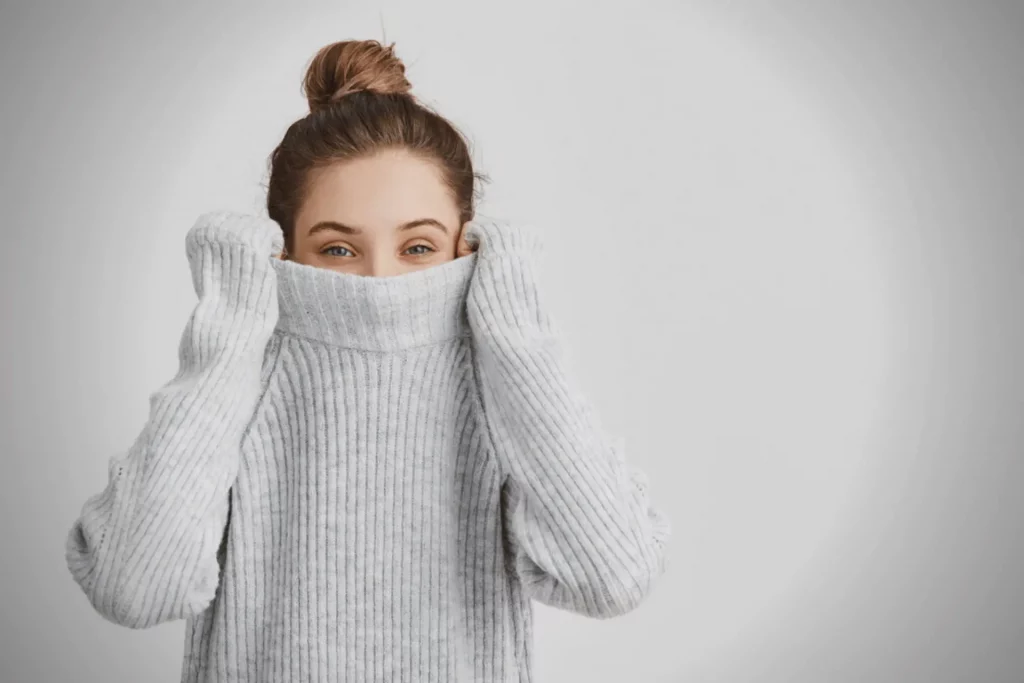When winter arrives, and the weather turns chilly, it is vital to keep warm since everything moves at a slower pace. Because it is more difficult to move about when it is chilly outside, wearing textiles appropriate for winter improves things. The more you bundle up, the better you’ll be able to do your tasks.
Is cashmere warm to wear in the winter than other materials? Cashmere indeed keeps you toasty in the cold. It is reported that this fabric can retain eight times more heat than wool. Some people believe that material derived from alpaca is the warmer of the two textiles, even though it is difficult to find a warmer fabric than cashmere.
Continue reading our post if you’d want more information on how cashmere may help keep you warm in the winter and why it’s a great choice overall. It has researched the topic and will provide the information essential to understanding.
Table of Contents
Cashmere Yarn:

Cashmere of the highest quality comes from China and Mongolia, two countries located in a region of the world with a climate that ranges from extremely cold (up to -40 degrees Celsius) in the winter to hot (over 30 degrees Celsius) in the summer.
The cashmere goats have developed a second fleece due to their adaptation to this climate. The rough outer guard layer protects the undercoat from moisture, while the incredibly soft, delicate undercoat offers warmth and protection from the bitter winter winds.
Please find out more about the origins of cashmere and the animals that produce it by reading more about where cashmere originates. The goats from this region have the thickest and finest hair, which results in the best yarn. Herders bring all their goats down the mountains in the spring to get rid of their winter coats and prepare them for the long, hot summer ahead.
Shearers shear the goat with much knowledge to obtain the required cashmere. When the shearing is complete, the hairs are separated into the fine undercoat and the coarse outside hairs or guard hairs.
Once the hair has been gathered, it is packed up and shipped to the yarn manufacturers, who spin and color the yarn after receiving it. The more intense the color they have to dye it, the greater the possibility it may wobble.
It should feel light, warm, and smooth as silk when the long cashmere yarn is woven into jumpers made entirely of cashmere. Because it is so lightweight, you won’t even feel like you’re wearing it, making it an excellent choice for the warmer months.
As long as you take care of it properly, it will be not only long-lasting but also breathable, keep you warm without being cumbersome, and endure for years and years.
Cashmere Is Perfect for the Winter:
The cashmere will keep you incredibly toasty over the cold months. In fact, in a toe-to-toe fight for warmth, cashmere won out over both cable knit and merino wool. The other textiles in the contest could not even match its rating of 8 out of 10.
Cashmere is also said to retain heat eight times better than normal wool. Considering all of these qualities, it becomes clear that this is an excellent cloth to wear when the weather begins to drop. On top of that, you receive superior comfort in the winter gear you have always desired.
Cashmere is the material of choice for keeping warm throughout the winter. The only issue is that the highest-quality cashmere that can be purchased to keep one warm comes at an extremely high cost.
The Advantages of Cashmere Throughout the Winter:
Cashmere is a very desirable and expensive material that is frequently utilized in the production of high-end clothing. Cashmere is regarded as a luxurious material due to the distinctive combination of characteristics that give it its reputation. Let us examine some of the advantages it possesses, including the following:
1. It’s Lightweight:

Cashmere is a fabric that is rather lightweight despite the level of warmth that it offers. Cashmere clothing does not tend to be bulky, making it an excellent choice for traveling because it will not require excessive space in your luggage.
2. It Has a Very Gentle Texture:
Cashmere is known for being extremely soft, which contributes to the luxurious appearance and feel of the material. Cashmere is produced from the cashmere goat’s undercoat, which has a very fine and silky fleece.
Cashmere is a fiber with a high loft, meaning air is trapped inside the fiber. This results in a velvety, soft fabric that has a smooth feel. If it is cared for properly, cashmere will get softer with age.
3. It Is a Cloth That Can Be Stretched:

Cashmere not only maintains your body temperature without adding extra weight, but it also has natural flexibility that does not restrict your movement while you are wearing it.
4. It Offers a High Level of Insulation:
Because cashmere may be up to eight times more insulating than regular sheep’s wool, it is an ideal choice for use in insulation. This is due to the harsh environment that cashmere goats live in, characterized by extremely low temperatures.
5. It Is Capable of Wicking Away Moisture From the Body:

Because cashmere has a high moisture content, its insulation adapts to the varying humidity levels in the air. Because of this, I am wearing cashmere is a pleasant experience regardless of the temperature.
The exteriors of the fibers are treated to repel water, while the inside is designed to attract water. This suggests that it extracts bodily moisture, such as through sweat, to work.
6. It Enables Your Skin to Absorb Oxygen Better:
Cashmere, on the other hand, allows your body to breathe, which helps your body regulate its temperature and keeps you toasty and comfortable. Synthetic fibers, on the other hand, can make you hot and sticky. Cashmere can be worn for longer without causing discomfort.
7. It Inhibits the Growth of Bacteria in Its Natural State:

Because cashmere is hypoallergenic, it is an excellent material for producing baby clothes and blankets and for use by those who have allergic reactions.
When It’s Wet, Does Cashmere Keep You Warm?
It is not a problem if the cashmere becomes somewhat damp. You will not suffer any reduction in the amount of warmth that the substance can provide. There is a possibility that you will smell a little bit like a wet dog while it is wet, but because the stench doesn’t become that severe, no one will detect any BO odor.
If you find yourself trapped in a downpour, try to protect the cashmere you are wearing from getting wet. The material is capable of absorbing water, at which point it will become incredibly heavy and restrict your movement. Once that occurs, you must be concerned with a few more aspects of the situation.
For instance, the combination of gravity and weight will work on stretching out your cashmere and cause it to lose its form. When you wish to wear your cashmere clothing, it is advisable to make sure that the day does not have any risk of storms. Cashmere is not fragile and can withstand light rain.
Wool vs. Cashmere: What’s the Difference?

Gentleness and a Nice Feeling:
Wool has the thickest fiber, making it the fiber with the most abrasion. It will irritate your skin, particularly if your skin is already sensitive.
Cashmere: The fibers of cashmere are hollow and much finer than wool, making it a lighter material. Out of all the wool fibers, this one is easily the finest and most delicate since it contains the tiniest scales and is the thinnest overall.
Durability:
Wool: The wool from Merino sheep is the most durable of all wools, while the wool is the least comfortable to the touch. In addition to this, in comparison to cashmere, wool has a longer lifespan.
Cashmere: Cashmere Although cashmere is undeniably long-lasting, the quality of the fabric must be carefully attended to and maintained to retain its luster.
Piling:

Wool: Wool tends to pill, but because it is not as soft as cashmere, it tends to pill less than cashmere. Wool is prone to pilling.
Cashmere: The fiber’s softness determines how easily it will pill when it comes to cashmere. Consequently, cashmere is more prone to being pilled than wool.
Maintenance:
Wool: Wool does need to be cleaned and dried properly, but because it is not a delicate fabric, no particular care or attention is required while caring for wool.
Cashmere: Because cashmere is so delicate, it requires more attention and care. Because it is a costly and fragile fabric, you probably don’t want it to get damaged too quickly.
Why Does Cashmere Keep You So Nice and Warm?

That question has more than one solution, one of which is that it has to do with the origin of the cashmere fiber. The animals that produce cashmere are referred to as cashmere goats, and they are native to regions of the world with very high average temperatures.
These areas are located in the Himalayas, including Nepal and Kashmir. Cashmere goats can create a natural fine under fleece that is also incredibly warm and soft since they must endure the harsh cold. After that, the under fleece is sheared, and the resulting material is used to make cashmere garments.
One further explanation is that the cashmere fiber possesses a one-of-a-kind insulation mechanism that allows it to sense when it is warm outside and when the temperature begins to drop.
Although it is difficult to describe, this insulation mechanism is one of the reasons why you can wear the same cashmere clothing throughout the winter and the summer and yet maintain a comfortable temperature in both seasons.
If it is cared for properly, cashmere may last very long. If you take proper care of this material, you can enjoy its benefits for many years.
Why Does Cashmere Come at Such A High Price?

The cashmere goats only have one shearing yearly; thus, the expensive wool is collected then. Cashmere of a high grade is almost exclusively produced in Mongolia because of the high demand for it and the country’s favorable climate for raising goats.
Every company that cares about quality wants to use Mongolian yarn, but the country cannot create enough of it. At a minimum, four goats are required to provide sufficient yarn for one sweater.
In comparison, just 600 tons of cashmere are spun into yarn yearly, whereas 1.3 million tons of lambswool are produced. It is a scarce commodity because it is a finite resource, which accounts for its high cost.
The price of cashmere fiber will only continue to rise as the demand for it rises since there is just one region in the world that can effectively grow goats that are the healthiest and have the longest hairs.
The temperature in the United States is not cold enough to produce goats with the finest or longest coats; therefore, despite efforts to breed from Mongolian goats, such efforts have been unsuccessful.
A word of caution: the cheaper the cashmere, the lower the possibility that it was produced from reliable farms in Inner Mongolia. This is something to keep in mind while making your purchase.
Taking Care of Cashmere and Ensuring Its Longevity:

Please take note of the following advice on washing and maintaining your expensive cashmere clothing.
Regularly hand washing cashmere garments help keep the fibers in good condition and maintain the garment’s new appearance. To get the most use out of our cashmere sweaters, we try to avoid washing them as much as possible and instead focus on spot cleaning as much as feasible.
This is OK for usage daily, but if you want to store your cashmere garments for a long time, we advise giving it a complete cleaning first.
Even if your cashmere sweater may not appear to be dirty, there is still a possibility that particles of food, dust, skin, and hair are embedded between the fibers. This increases the probability that your sweater will attract moths and become damaged.
We strongly suggest that you clean your cashmere by hand at all times:
- Locate a clean bowl or sink devoid of any food, dirt, cleaning product, or other residues that might affect your cashmere.
- Soak in warm water with mild soap.
- Flip the item of clothing inside and clean it by gently squeezing it and rolling it if required. Do not rub or wring it. Do not apply any pressure to the garments as you wait for the detergent to do its task. It is recommended that each article of cashmere apparel be washed in its machine.
- Rinse carefully with lukewarm water. We strongly suggest that you use water that is the same degree as the liquid you used to wash the item in the first place.
When drying your cashmere apparel, you must keep a few important things in mind:
- Lay it out on a towel and let it air dry away from direct heat and sunlight sources. Because the water weight might cause the cashmere to stretch out of shape, we do not advocate hanging cashmere items so they can dry.
- Never put your cashmere clothes in the TUMBL dryer! It will result in a diminishing.
- To remove extra water from the clothes, do not wring it or twist it in any way; instead, be patient and treat it as it ought to be treated, gently and with care. Cashmere quality will most likely increase as it ages and becomes softer.
Ensure that your cashmere is stored appropriately:
- It should be kept inside out, in a place that is free of dust and has enough ventilation, and it should not be exposed to direct sunlight.
- If you plan to store your clothes for an extended period, you should first ensure that it has been thoroughly washed, as traces of filth, dead skin, or dust may serve as an invitation to various insects.
- If you plan to put it away for the summer, we suggest you thoroughly clean, smooth out any wrinkles or pills, and then put it away safely.
- The same principle applies to the area where you plan to keep it; check to see if it is free of dust and the humidity level is low. Utilize a storage bag to keep your cashmere in excellent condition.
Some Information Regarding Cashmere:
The more you know about this material, the easier it will be for you to decide whether or not you will purchase it, what you will wear with it, and how you will wear it. Familiarizing with the material enables you to create fantastic sewing and craft projects.
- Goats from Kashmir, Nepal, and Tibet are the source of cashmere, combed from their undercoats. Now, this animal species is being bred in Mongolia and New Zealand to increase output.
- Even though it is a very thin fabric, it can keep people warm in temperatures as low as -40 degrees Fahrenheit.
- The wool from three to five goats is required to manufacture a single cashmere garment.
- The oldest factory in Europe producing cashmere garments opened its doors in 1797 in Elgin, located in Scotland.
- In a single year, a single cashmere goat may only generate roughly four to six ounces of the delicate under fleece utilized to make cashmere.
- Cashmere is only available in three hues: gray, brown, and black; but, because the material can take dyes, you can modify the colors of your cashmere if you like.
- It is said that the fiber used to make cashmere is approximately six times finer than a real human hair.
- Roman noblemen used this cloth, but it wasn’t until approximately the 18th century that it became popular with royal families across Europe.
- In Kashmir, some families continue the centuries-old practice of weaving and spinning cloth by hand.
Frequently Asked Questions:
Do Cashmere Gloves keep you warm?
Cashmere-lined gloves help keep your hands cozy. There’s one thing you should know before buying a pair. Cashmere filling lasts 2-years. The fabric is fragile, so hand friction runs the strands. Even if you like those gloves, they won’t be around for long. Every few years, replace them. Fleece-lined gloves are toasty. These insulated gloves reportedly keep hands warm and last longer than others. Instead of cashmere, use fleece. After shopping, you’ll be warm and have money for lunch.
Is cashmere too warm to wear during the summer?
The extraordinary capacity of cashmere to regulate body temperature is one of its many desirable qualities. It helps you keep your body heat in during the colder months to remain toasty and comfortable. It does the opposite during the warmer months to maintain your coolness despite the rising temperatures.
What’s warmer Fleece or Cashmere?
This comparison is contentious. Some think a 6-ply cashmere sweater couldn’t equal fleece’s warmth. This sweater costs over $1000. Others say cashmere is the warmest. Cashmere looks prettier and is more comfortable than fleece, so even if it weren’t warmer, more people would wear it for the style. With fleece-lined gloves and other garments, fleece wins. It’s cheaper than cashmere and lasts longer. After two years, you’ll need new gloves.
What to wear under a Cashmere Sweater?
Women have more cashmere sweater layering choices. Shirts, blouses, shirtdresses, T-shirts, undergarments, and more. V-neck cashmere can have a bow tie added. Under a sweater, ladies may wear anything. Men have T-shirts, undershirts, and formal shirts. You may be imaginative and build your order-sweater style. When appropriate, some people wear nothing. You must wear the clothes all day, so choose wisely. Make sure your choices match the occasion.
Bottom Line:
Cashmere is the material to use if you need something to keep you warm that is not cumbersome. Cashmere clothing is often very breathable and lightweight. Cashmere has a higher degree of shape retention than wool when properly cared for.
It maintains its shape better than wool and is not affected by the washing process. There is no doubt that the price may be a bit too much for some people, but it is an investment that only has to be made once because your cashmere clothing may last for a very long time if it is cared for correctly.

